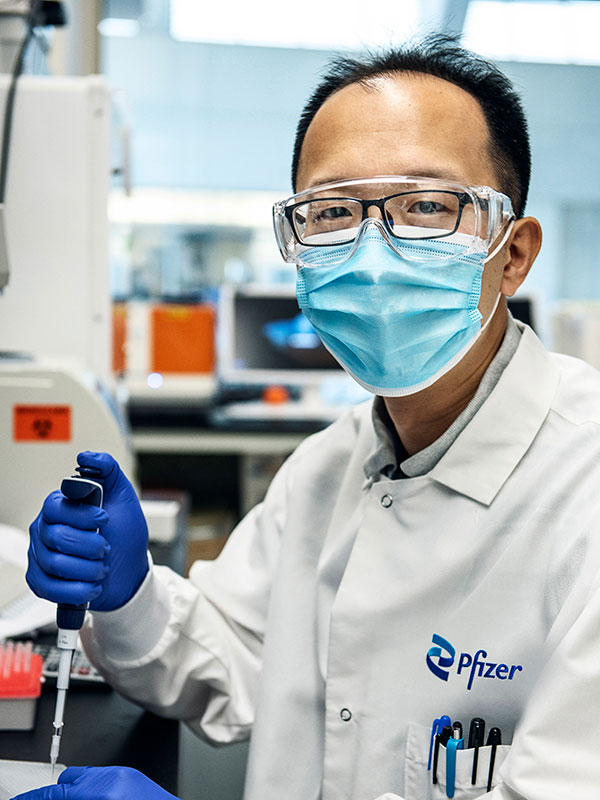- Science
- Clinical Trials
- Guide to Clinical Trials Your participation makes a difference
- Clinical Trials in Children Designed to improve kids' health
- Data and Results Sharing our Results
- Integrity and Transparency Building Trust
- Diversity Equity and Representation
- Plain Language Study Results Trial Result Summaries
- Expanded Access & Compassionate Use Possible Treatment Options
- Find a Trial
- Areas of Focus
- Rare Disease Smaller populations but big impact
- Internal Medicine Extending lifespans worldwide
- Inflammation & Immunology Treatment at the molecular level
- Vaccines Preventing the spread of infections
- Oncology The science of optimism
- Anti Infectives Combatting an evolving risk
- Areas of Innovation
- Gene Therapy Breakthroughs become treatments
- Medicinal Sciences The next generation of science
- Precision Medicine Developing tailored medicines
- Maternal Immunization Protecting newborns at the start
- mRNA Technology Unleashing the next wave of scientific innovations
- Diseases & Conditions
- Coronavirus Resources
- Product Pipeline
- Research Sites
- Clinical Trials
- Products
- How Drugs are Made
- Branded vs. Generic Learn the difference
- Biologics & Biosimilars Cures found in nature
- Commitment to Quality Maintaining the highest standards
- Global Supply Strategic manufacturing locations
- Manufacturing Sites Where medicine is made in the U.S.
- Medicine Safety
- Health Literacy Learning to be well
- Treatment Choices Learning about treatment decisions
- Partnering With Patients Helping others by reporting side effects
- Tips for Patients Preventing medication errors
- Reporting Adverse Events
- Counterfeiting Preventing medication errors
- Product Safety
- Product List
- Product Contacts
- PfizerPro for Professionals
- Patient Assistance Programs
- Distributors
- How Drugs are Made
- Stories
- Newsroom
- About
- People
- Executives Our senior-most leadership
- Board Members The people steering our company
- Scientists Our experts making discoveries
- Patient Stories Our patients
- Colleague Stories Our colleagues
- Responsibility
- Ethics & Compliance Each of us is responsible
- Responsible Business Breakthroughs that change patients’ lives
- Patient Advocacy & Engagement Putting Patients First
- Global Impact Meeting urgent needs worldwide
- Diversity, Equity, and Inclusion Everyone has something to offer
- Environmental Sustainability Our responsiblity to the environment
- Human Rights Furthering dignity and worth
- Health & Safety
- Intellectual Property The benefits of fair competition
- EHS Governance
- Misinformation
- Programs & Policies
- Grants Support for independent research
- Political Partnership Supporting like-minded organizations
- Working with Healthcare Professionals Collaboration to improve lives
- Prescription Value & Pricing How to lower patient costs
- Privacy Principles Commitment to personal data privacy
- Ready for Cures Improving Access to Medicines
- Transparency in Grants Committed to Disclosure
- Policy Positions
- Investors
- Investors Overview Information for stockholders
- Why Invest Why to join us in our mission
- Events & Presentations Calendar of upcoming events
- Financial Reports Quarterly reports and more
- Investor News Announcements about our performance
- Stock Information Charts and data
- Shareholder Services Information on stock transactions
- Corporate Governance
- Corporate Governance Overview Gaining insight into our performance
- Board Committees & Charters Defining the corporate structure
- The Pfizer Board Policies Ensuring ethical leadership
- Corporate Governance FAQs Learn more about our approach
- Contact Our Directors Email any of our Directors
- Purpose
- History
- Careers
- Partners
- People
10 Key IP Principles That Unify the Biopharmaceutical Industry
The IP PACT (Intellectual Property Principles for Advancing Cures and Therapies) is a unified statement by members of the innovative biopharmaceutical industry to affirm our strong commitment to keeping the needs of patients at the center of our approach to IP.
The IP PACT is a set of voluntary commitments that sets out a framework for greater trust and collaboration and guides the signatories’ approach to IP
This is crucial at a time when IP is proving to be a fundamental enabler to breakthrough medical innovation and significant scientific advances.
Read the IP PACT PDF DetailsIP Policy: Patient Benefit at the Center

How we use IP matters for our efforts to take on the toughest healthcare and medical challenges around the world. We explain our approach in our Intellectual Property Policy Position document, which reflects our long-standing commitment to keeping patients at the heart of our IP practice. See for yourself how we’re living up to that commitment.
Read our Patent Policy Position PDF DetailsDr. Aida Habtezion
Chief Medical Officer and Head of Worldwide Medical and Safety
Dr. Habtezion explains that as we develop new science, technology, medicines, and vaccines, we’re simultaneously creating and supporting pro-patient, pro-innovation policies that guide our approach to intellectual property
Intellectual Property 101
- What Is Intellectual Property?
Intellectual Property (IP) refers to creations of the mind, such as inventions, literary and artistic works, and in our case, novel medicines.
Legally, IP rights allow the owner of the property to benefit from their creation by giving them control over how their property is used.
- What Are the Different Types of IP?
Intellectual Property may include:
Patents to protect inventions: products and processes that are capable of industrial application
Trademarks to protect brand identity: identifying goods and services and distinguishing the source of the goods and services from other traders
Designs to protect product appearance: the whole or a part of a product’s appearance (e.g., features such as lines, contours, colors, shape, texture, or materials)
Copyrights to protect creative works: literary and artistic material, music, films, sound recordings and broadcasts, including software and multimedia
Trade Secrets to protect confidential information that provides a competitive advantage: most commonly technical or business information; for example, manufacturing processes, pharmaceutical test data, distribution methods
- Why Do Governments Protect IP and Who Benefits?
Governments establish and enforce intellectual property primarily to stimulate innovation in knowledge-intensive fields and encourage the production of useful goods and services arising from knowledge-based inventions.
The establishment and protection of IP rights reflects a balance intended to advance the interests of inventors and society.
Through these laws, governments enable the right-holder to exercise ownership rights over their invention for a limited period of time, and in return the IP benefits society by stimulating the development and commercialization of goods and services. This promotes economic growth and job creation and expands society’s supply of technical and scientific knowledge.
- How Does IP Enable Pfizer to Bring Breakthroughs That Change Patients’ Lives?
As in any industry, protecting IP encourages further investment.
Where inventions can be protected and patents enforced, biopharmaceutical innovators have the predictability and certainty that’s needed to invest in research, collaborate with partners, compete successfully, and accelerate the launch of new medicines.
Safeguarding innovations through strong protection and enforcement of patents, regulatory test data, and other intellectual property provides powerful incentives that drive and sustain investments in valuable treatments and cures for patients.
For example, the incentives provided by the IP system enabled Pfizer to build an infrastructure that allowed us to quickly mobilize and devote the resources, technical knowledge and know-how that is required to combat the COVID-19 pandemic.
Maintaining that system is what will fuel the next generation of solutions and allow us to tackle any future crisis.
- What is the WTO TRIPS Agreement & Doha Declaration?
In 1994, the World Trade Organization’s (WTO) Agreement on Trade-Related Aspect of Intellectual Property Rights (TRIPS) set down minimum standards for many forms of IP rights.
To date, all members of the WTO have been required to adopt TRIPS-compliant IP laws, with the exception of the least developed countries, which have a time-limited extension.
In the Doha Declaration on TRIPS and Public Health, WTO member governments reaffirmed the importance of IP protection in creating incentives for the discovery and development of new medicines, particularly for infectious diseases, while also recognizing WTO members’ rights to protect public health.
- Does IP, Particularly Patents, Restrict Access to Medicines in the Developing World?
Patent protection has been proven to stimulate research and development for new and improved medicines for diseases, including those which are prevalent in the developing world.
The vast majority of medicines prescribed around the world today are off-patent generic or biosimilar treatments. In fact, most of the products on the World Health Organization’s Essential Medicines List are off-patent.
To improve access to medicines in a meaningful way, a holistic approach is needed that recognizes the many complex factors that contribute to lack of availability or affordability. Examples include poverty, lack of health education, limited healthcare infrastructure, regulatory delays, shortage of trained healthcare workers, distance to hospitals, treatment centers, or other community health organizations.
The biopharmaceutical industry regularly partners with governments, non-governmental organizations (NGOs), and other stakeholders, including patients, to help address these factors.
- What is Regulatory Data Protection and Why is it Important?
Regulatory Data Protection (RDP) safeguards the information submitted by an innovator to a regulatory authority.
In the case of biopharmaceuticals, this prevents a competitor (usually a generic company) from using the data submitted by an innovator company to a government agency to provide evidence that a medicinal product meets the national standards of quality, safety, and efficacy.
RDP lasts for a limited period. At this expiration the data may then be relied upon to support the authorization of similar products.
The incentives provided by the patent system and RDP are independent yet complementary:
A patent is a set of exclusive rights granted to an inventor for a limited period of time in exchange for detailed public disclosure of an invention.
RDP is a right granted upon approval of a new drug, that prevents other applicants from relying on the innovator’s test and trial data for that drug, for a limited period of time.
Both serve to incentivize continued innovation and are essential components in the legal protection of IP.
Our Responsibility
Our resources allow us to do more for people. Using our global presence and scale, we’re able to make a difference in local communities and the world around us.










